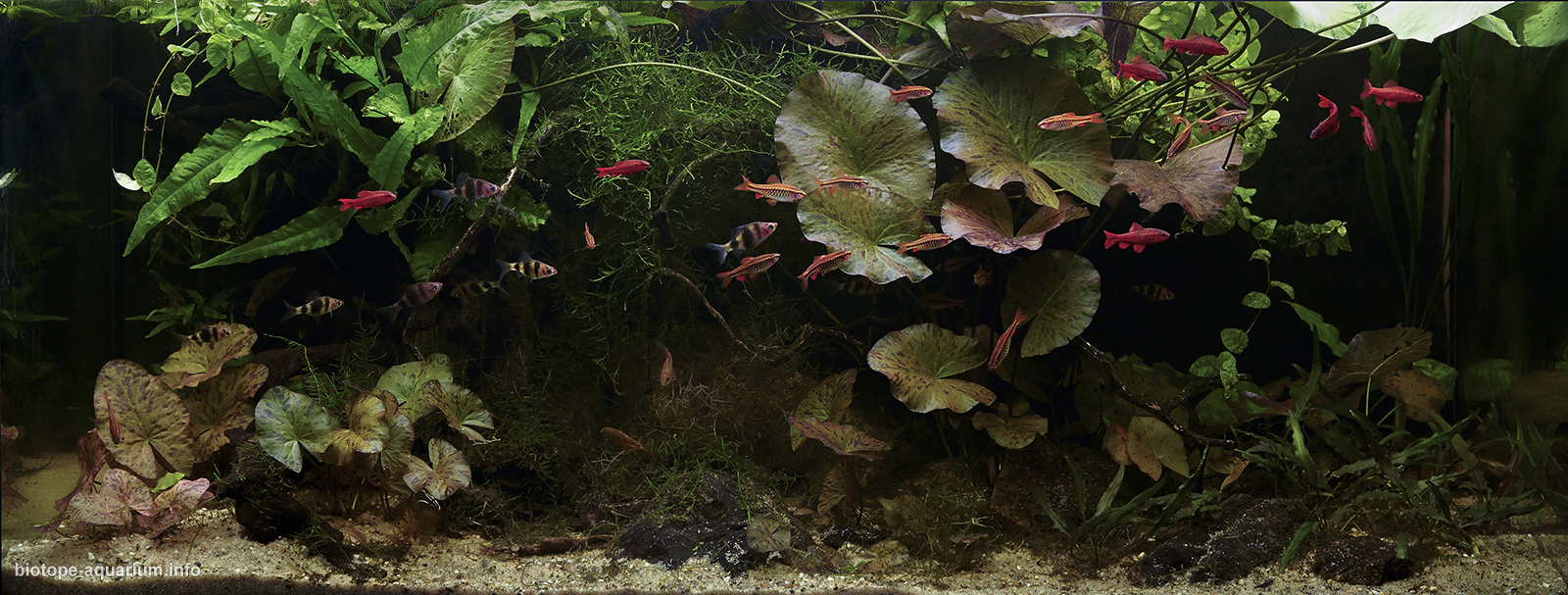Forest Stream of the Nilwala River Basin, Sri Lanka
_st place in Biotope Aquarium Design Contest 2022

Volume of aquarium: 156 L
Dimensions of aquarium: 100x39x40 cm
List of fishes: Pethia nigrofasciata, Puntius titteya
List of plants: Cryptocoryne wendtii, Nymphaea sp.; Cryptocoryne balansae, Cryptocoryne retrospiralis, Microsorum pteropus, Vesicularia dubyana, Ficus pumila
Description of Decorations and Substrate: DECOTOP Atoyac – Natural pure yellow sand, 0.1-0.5 mm, Gray-brown stone DECOTOP Olympus, driftwood DECOTOP Sumatra
Description of Equipment: external filter JBL CristalProfi greenline e901, lamp Solarcolor T5 45 w, Solarnatur T5 45w, heater Tetratec NT 100, 100 w
Water Parameters: pH 6.8, dH 6°; the temperature is 24°C
Additional Info: Ficus pumila was used as an imitation of above-water vegetation, whose branches descend into the water. The plant was laid on the screed of the aquarium, the roots were wrapped in a sintepon, which was moistened from time to time. Pretty soon the branches of the plant sank into the water and gave underwater roots. The leaves on the shoots that are under water gradually die off. However, this does not prevent the plant from feeling good and working as a phytofilter – the nitrate level in the aquarium never exceeds 20 mg/l.To ensure that the other plants in the aquarium do not suffer from a lack of nutrients, fertilizers in tablets are regularly used, and liquid fertilizers are used for ferns and mosses.
Aquarium video:
Description of the Area Surrounding the Biotope: Nalivala is one of the rivers of Sri Lanka, it begins in the Sinharaja Biosphere Reserve and flows into the sea near the large city of Matara on the southern coast of the Southern Province, 160 km away. from Colombo. The length of the river is 72 km, its drainage basin is 922 km2. Sinharaja Forest Reserve is a national park of Sri Lanka, in 1978 it was recognized as a World Biosphere Reserve, and in 1988 – a UNESCO World Heritage Site. According to the International Union for Conservation of Nature (IUCN) Sinharaja is the last viable rainforest area of the country. More than 60 percent of the tree species there are endemic.
Description of the Underwater Landscape of the Biotope: The aquarium presents a coastal section of a slowly flowing stream. The light sand is sometimes covered with a layer of silt, driftwood and leaves are found in the water, branches of shrubs growing along the banks of the stream sink into the water and form a shading zone near the shore. Pythia nigrofasciata and Puntius titteya like to stay in such places, they spawn there, among the thickets of aquatic vegetation
Description of the Habitat Parameters: Water in the forest river is transparent, pH = 5.3 – 6, TDS = 10, temperature 23-24
List of Fishes and Invertebrates Occurring in the Nature Biotope: Puntius nigrofasciatus, Puntius sinhala, Barbus vittatus, Puntius bimaculatus, Rasbora wilpita, Etroplus maculatus, Channa orientalis, Devario malabaricus, Garra ceylonensis, Puntius dorsalis, Puntius pleurotaenia, Aplocheilus dayi werneri, Etroplus maculatus, Etroplus suratensis, Mystus ankutta, Mystus cavasius, Poecilia reticulata
List of Plants Found in the Nature Biotope: Eichhornia crassipes, Ludwigia adscendens, Salvinia molesta, Pistia stratiotes, Marsilea quadrifolia, Lagenandra thwaitesii, Cryptocoryne wendtii, Lasia spinosa
Threats to the Ecology of the Biotope: Human activity in Sri Lanka, as elsewhere in the world, damages the habitats of many species. The Sinharaja Nature Reserve is a protected place, but the rivers flowing there are also exposed to civilization outside the reserve. The situation is worse in other regions. For example, Cryptocoryne parva is endemic to the Mahaveli River, and due to anthropogenic factors, its existence on our planet has been under threat for several decades. The construction of dams on the Mahaweli Ganga River leads to the flooding of huge areas of coastal forests and their extinction, and blasting during the construction of dams leads to mass death of fish. Many species living in the reservoirs of Sri Lanka are endemic and need protection.
Sources of Information:
https://www.aquaflore.ru/puteshestviya/128-ryby-shri-lanki.html
https://www.aquaflore.ru/puteshestviya/122-krov-zakon-i-lagenandra-tvejtsa-lagenandra-thwaitesii.html
https://www.aquaflore.ru/novosti/111-shri-lanka-2015-pervye-vpechatleniya.html
https://www.aquaflore.ru/puteshestviya/143-zhivye-turmaliny-shri-lanki.html
https://www.aquaflore.ru/puteshestviya/158-poslednij-oplot-kriptokoriny-malenkoj-cryptocoryne-parva.html
https://www.aquaflore.ru/novosti/110-na-tsejlon-za-kriptokorinami-i-lagenandrami-prolog.html
https://www.fishbase.de/summary/Pethia-nigrofasciata.html
https://www.fishbase.de/summary/Puntius-titteya.html
